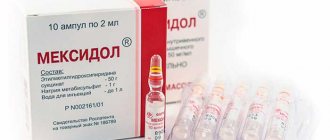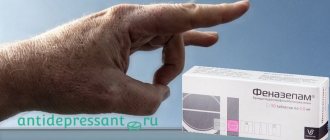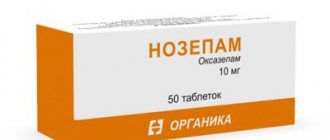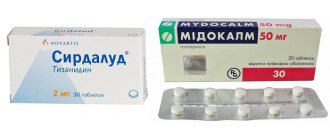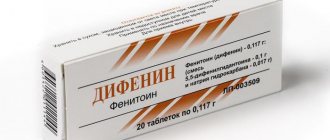Contraindications for use
The use of Velfax is impossible in the following cases:
- In case of serious impairment of kidney function;
- If the normal functioning of the liver is disrupted;
- Patients under 18 years of age;
- In combination with monoamine oxidase inhibitors (MAO);
- During pregnancy and lactation;
- In case of hypersensitivity and intolerance to the components in the composition of the drug;
Patients with arterial hypertension, as well as patients with unstable angina, tachycardia, and after a myocardial infarction should be extremely careful during treatment with Velafax.
In addition, Velafax should be used with caution in case of increased intraocular pressure, angle-closure glaucoma, hypovolemia, dehydration, as well as in patients with low body weight.
Method of use and dosage
Velafax tablets are intended for oral use; they should be taken with plenty of water and taken with meals. Doctors advise taking pills at the same time of day to maximize the effect of taking them.
Typically, the doctor determines the dosage and duration of treatment therapy, depending on the complexity and severity of the disease.
The usual dosage of Velafax is 37.5 ml 2 times a day. If treatment fails, the dose can be increased to 75 mg 2 times a day. For severe depression, the initial dosage is 75 mg, and can be increased to a maximum of 375 mg per day.
If there is an improvement in the patient's general condition, doctors may reduce the dose used. Therapeutic therapy will last 6 months.
In cases of mild renal failure, the initial dosage does not need to be adjusted.
Elderly patients should also not increase the dosage, in addition, the course of treatment should be carried out under the strict supervision of a doctor.
In the event that it is necessary to stop using Velafax, doctors advise gradually reducing the dosage until complete cessation. Cancellation of Velafax should occur gradually over at least 1 week. And patients who have been on treatment for 6 weeks can reduce the dosage to 2 weeks.
In case of relapses, use the initial dosage of Velafax and try to gradually reduce it.
Composition and release form
The antidepressant Velafax is available in the form of tablets with a concentration of the active substance of 37.5 or 75 mg. The active ingredient is venlafaxine hydrochloride, auxiliary components: starch, cellulose, talc, magnesium stearate, silicon dioxide.
Pharmacological properties
According to the official instructions for use of Velafax, the drug cannot be classified into any group of neurotropic drugs based on its chemical structure. It is not similar to tetracyclic and tricyclic antidepressants or other known chemical compounds with antidepressant efficacy. Does not apply to tranquilizers.
The mechanism of action of the drug lies in its ability to stimulate the transmission of electrical impulses in neurons and significantly inhibit the reuptake of serotonin and norepinephrine. Slightly less inhibits dopamine uptake. When using the drug, a decrease in beta-adrenergic activity was observed.
There was no effect on cholinergic, alpha-adrenergic, opiate, muscarinic, benzodiazepine or histamine receptors. It has no effect on the activity of MAO.
Maximum concentrations of the drug are achieved within two hours after oral administration. Eating may slow down the absorption of venlafaxine. Metabolized in the liver, excreted by the kidneys.
Negative influence
Velafax is able to influence the functioning of many body systems:
- Nervous system – patients experience a feeling of fatigue, dizziness, increased drowsiness, sometimes there is sleep disturbance, tremors, apathy, epileptic seizures;
- Digestive system disorder: loss of appetite, vomiting, nausea, diarrhea, constipation, pain in the abdominal area, hepatitis, in very rare cases pancreatitis;
- Mental disorders: depression, suicidal thoughts;
- Metabolic disorders: body weight either increases or decreases, there is a high level of cholesterol in the blood plasma;
- The hematopoietic system is disrupted and the lymphatic system malfunctions: thrombocytopenia, hemorrhages in the skin and mucous membranes, anemia;
- Impaired functioning of the cardiovascular system: high blood pressure, hypotension, tachycardia, fainting, arrhythmia;
- Respiratory system: shortness of breath, pulmonary failure;
- Urinary system: urinary retention, disturbances in the process of urination;
- Damage to the senses;
- Dermatological disorders: increased sweating, alopecia;
- Disruption of the endocrine system: galactorrhea, high concentration of prolactin;
- Musculoskeletal system and various allergic reactions.
Such a negative effect may be caused by the fact that the patient’s body has become addicted, in which case it is necessary to stop treatment and consult a doctor.
Admission rules
Velafax tablets are taken orally with water. It is recommended to take with food. The dosage and duration of treatment are prescribed by the attending physician.
In severe conditions, treatment can begin with 150 mg per day, but this is only justified in a hospital setting. The dosage must be divided into several doses. The maximum daily dosage is 375 mg per day. When the desired result is achieved, the dosage is gradually reduced.
Maintenance treatment can continue for six months at the lowest effective dosage. Discontinuation of therapy should be gradual.
Discontinuation of the drug lasts at least two weeks with careful monitoring of the patient's condition.
Special categories
Patients with mild renal failure do not need to adjust the dosage of the drug. With moderate severity of renal pathologies, the dosage is reduced by a third. Since the elimination of the drug in such patients lasts longer, the daily dosage is taken at one time.
For severe kidney pathologies, Velafax is not prescribed. Patients on hemodialysis can take tablets with a dosage reduced by half after hemodialysis.
For mild liver failure, there is no need to change the dosage. Moderate liver failure requires a dosage reduction by half. For severe liver pathologies, Velafax is not prescribed.
The elderly do not need to adjust the dosage if renal and liver function is preserved. If there are pathologies, correction is carried out in accordance with the above recommendations. Patients over 65 years of age require more careful monitoring by the attending physician, including when changing dosages.
Pregnant and lactating women
Drug therapy is contraindicated while pregnant. Before starting treatment with Velafax, pregnancy should be excluded, and reliable contraceptives should be used during the course of therapy.
When used in the third trimester of pregnancy, the development of withdrawal syndrome in a newborn child cannot be ruled out.
The active substance and its active metabolite are found in breast milk, therefore breastfeeding is contraindicated during therapy. If treatment with Velafax is unavoidable, the option of transferring the child to artificial feeding should be considered.
Adverse reactions
Adverse reactions of the drug depend on the dosage and duration of treatment. At the beginning of therapy, side effects are more common; with long-term treatment, they are recorded less frequently.
From the central nervous system, effects such as nightmares, high fatigue, dizziness, and problems falling asleep may occur. Patients note a feeling of goosebumps, trembling of the limbs, yawning, and increased muscle tone.
Reactions such as apathy, muscle spasms, hallucinations, epileptic seizures and manic reactions have rarely developed.
The gastrointestinal tract may react with appetite disturbances, vomiting, nausea, dry mouth and bowel movements. The heart and blood vessels respond with tachycardia and decreased blood pressure.
When studying laboratory blood parameters, changes in liver tests, insufficient release of vasopressin and a decrease in the concentration of sodium in the blood serum are noted.
The reproductive system may respond with decreased erectile function, ejaculation problems, urinary retention, and decreased libido. Other side effects include thrombocytopenia, taste changes, blurred vision.
Additional Information
During a depressive state, the patient very often experiences suicidal thoughts, which will manifest themselves until the therapeutic effect of Velafax occurs. The return of depression can lead to new psychological disorders, so the patient should be constantly under medical supervision, even after completion of treatment. Suicidal thoughts most often occur in patients during the initiation of treatment therapy.
In no case should Velafax be used to treat patients with uncontrolled epilepsy; in the case of controlled epilepsy, the patient should be under doctor's supervision and if seizures occur, therapy should be stopped.
In addition, patients may develop psychomotor restlessness. This usually happens in the first weeks of using Velafax.
Extreme caution should be given to patients prone to tachycardia, as well as elderly patients and those with impaired renal function.
Velafax should not be used simultaneously with phentermine and other drugs that can cause weight loss.
It is necessary to strictly adhere to the regimen of Velafax and its dosage. In addition, the patient must remain under medical supervision at all times. During treatment, you should not drink alcoholic beverages. It is not recommended to drive a car or do other activities that require concentration.
Withdrawal syndrome and other features
Abrupt cessation of therapy may lead to the development of withdrawal syndrome, which includes the following symptoms:
- increased fatigue;
- headache;
- loss of appetite;
- stool disorders;
- anxiety, insomnia;
- low concentration;
- excessive sweating;
- anxiety, dizziness.
The symptoms are mild and go away on their own, but they reduce the patient’s quality of life, so treatment should be stopped gradually.
Therapy is started with low doses to prevent the risk of suicide attempts in patients with depression. Patients with mood disorders are at risk of developing hypomania and mania.
If allergic reactions develop, it is necessary to stop treatment with the drug and carry out symptomatic treatment.
Overdose
An overdose of the drug is accompanied by conditions such as changes in electrocardiogram parameters, ventricular tachycardia, hypotension, bradycardia, disturbances of consciousness and convulsions.
In case of simultaneous overdose with other antidepressants or alcohol, cases of death are known.
In case of overdose, symptomatic treatment is carried out, constantly monitoring the functioning of the respiratory function and blood circulation. Absorbents are effective during the first hour after an overdose. Do not perform gastric lavage or induce vomiting.
Drug interactions
Velafax should not be combined with MAO inhibitors. A two-week break between drugs is required. Does not affect drugs based on lithium, diazepam, imipramine.
May increase serum concentrations of haloperidol and clozapine. Combination with electroconvulsive therapy has not been studied. Velafax potentiates the anticoagulant effect of warfarin.
Medicines that inhibit the activity of hepatic cytochrome isoenzymes do not significantly change the effectiveness of the drug. The metabolism of Velafax in the liver is inhibited when used together with Cimetidine.


